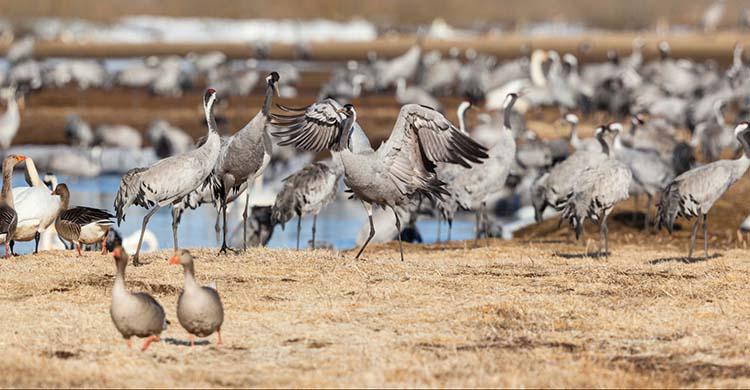
Scientific Task Force on Avian Influenza and Wild Birds Issues Recommendations
In response to recent large-scale outbreaks of highly pathogenic avian influenza (HPAI) in wild birds, the Secretariat of the Convention on the Conservation of Migratory Species of Wild Animals (CMS) and the Food and Agriculture Organization of the United Nations (FAO) convened the Scientific Task Force on Avian Influenza and Wild Birds.
The highly pathogenic avian influenza H5N1 virus, plus other subtypes including H5N8 caused multiple avian influenza outbreaks that occurred in the UK, The Netherlands, Israel, and India seriously affecting wild birds.
The Scientific Task Force on Avian Influenza and Wild Birds provided recommendations and guidance for authorities and managers of countries affected or at risk.
CMS Executive Secretary Amy Fraenkel said: "We are pleased to share the advice of the Task Force and key recommendations for countries affected or at risk, and look forward to continuing our collaborative work to minimize risks to humans, poultry and wild populations of migratory birds."
Wild birds, including globally threatened species, are victims of HPAI viruses causing avian influenza. Affected sites also include areas of international relevance for conservation such as protected wetlands.
Authorities with responsibility for animal health should apply One Health approaches for communicating and addressing avian influenza. That means recognizing that the health of humans, domestic and wild animals, plants, and the wider environment are interlinked and acting with a coordinated and unified approach.
It is recommended that surveillance and biosecurity measures be reinforced to reduce spillover risk between poultry and wild birds. Authorities need to fulfil their international obligations to avoid the culling of wild birds and damage to natural ecosystems, especially wetlands.
Dr. Ruth Cromie, coordinator of the Task Force said: "Avian influenza represents a One Health issue threatening health across the board. The highly pathogenic viruses are still relatively new in wild birds and this winter's high levels of mortality remind us of their vulnerability and that working to promote healthy wildlife benefits us all."
H5N1 is currently the avian influenza lineage most found in Africa and Eurasia in both poultry and wild birds. It affects wildfowl, waders, gulls, cranes, grebes, herons, pelicans, gamebirds, corvids and raptors, and occasionally mammals such as Red Fox (Vulpes vulpes), Eurasian Otter (Lutra lutra) and Harbour (Phoca vitulina) and Grey Seal (Halichoerus grypus).
In terms of human health, the currently circulating H5N1 HPAI viruses do not seem to pose the same zoonotic risk as the 'original' Asian lineage H5N1 (clade 2.2 and their derivatives plus clade 2.3.4.4b H5N6 viruses currently in China). Considering people working on poultry culling operations, the risk can be considered as moderate.
General recommendations concerning different categories of animals affected include:
Wild birds:
• There is no benefit in attempting to control the virus in wild birds through culling or habitat destruction
• All those with responsibilities for animal health are reminded of the advice of FAO and OIE, and international obligations under CMS, the Ramsar Convention and the Agreement on the Conservation of African-Eurasian Migratory Waterbirds (AEWA), to ensure that there is no consideration of killing of wild birds, spraying toxic products or negatively affecting wetland and other habitats as disease control measures
Poultry:
• Responses to HPAI in poultry must follow OIE international standards, guidelines and recommendations on notifications, surveillance, diagnosis, trade and control measures
• Biosecurity should include efforts to prevent the spread of infection from infected poultry holdings to wild birds
• A reorganization of poultry production systems highly susceptible to avian influenza exposure will minimise the risk of virus introduction and further spread
Captive birds:
• There is no justification for any pre-emptive culling of zoological collections